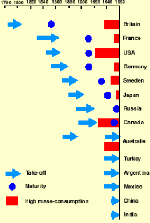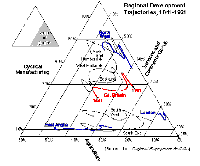|
Editorial
Abstract
Introduction
Visualising Mobility
Visualising transitions
Visualising trajectories
Discussion
Conclusions
Acknowledgements
References
Case Studies Index
|
Mapping the Life Course:
Visualising Migrations, Transitions &
Trajectories
4. Visualising Trajectories in the `lives' of nations and
regions
The examples discussed so far concern people's lives, but the methods are
relevant to any entity capable of change over two or more dimensions: firms are
created, merged and de-merged, and closed down; products and political parties
are `repositioned' in the marketplace. Two final examples concern nations and
regions.
Firstly, perhaps the best know `transition diagram' in the history of the
social sciences, and one of the most problematic. Nations, like people, follow
a variety of paths but Rostow's `stages of economic growth' (1960)
allows them just one: arguably, the American Way. Even though the fallacy was
demonstrated decades ago, students still arrive at university having been
taught this model, arguably a testament to the power of graphics. Treatments
such as Solow's (1970) may contain far more insight into the real processes of
economic growth, but though it contains diagrams they provide detail not
overview. Rostow's diagram shows the fundamental danger of two dimensional
visualisations in this field: if one axis is time and the other distinguishes
cases (just like the SEM diagrams above), there is no space within which
nations can follow different paths and as with individual life-cycle models the
only variation is in timing.
Figure 9: Walt Rostow's `Stages of Economic Growth'

Figure 10, taken from Gilbert & Southall (1994) takes a slightly more
sophisticated approach to the economic development of the regions of Britain,
plotting their trajectories in terms of industrial structure between 1841 and
1931. It attempts to present five dimensions on a two dimensional surface:
time, the three economic sectors and the geographical dimension which
distinguishes the regions. Despite its complexity, this is still a
simplification from the original statistics for 32 sectors and 52 counties. It
should be apparent that each of the three regions highlighted in blue followed
a markedly different path, and the national path (in red) was an average
between these very different patterns.
Figure 10: Regional Development Trajectories,
1841-1931

|



